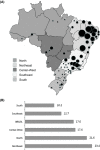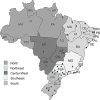Genetics and genomics in Brazil: a promising future
- PMID: 25077170
- PMCID: PMC4113268
- DOI: 10.1002/mgg3.95
Genetics and genomics in Brazil: a promising future
Figures



Similar articles
-
The Evolution of Science in a Latin-American Country: Genetics and Genomics in Brazil.Genetics. 2018 Mar;208(3):823-832. doi: 10.1534/genetics.118.300690. Genetics. 2018. PMID: 29487143 Free PMC article.
-
Genetic education, knowledge and experiences between nurses and physicians in primary care in Brazil: A cross-sectional study.Nurs Health Sci. 2017 Mar;19(1):66-74. doi: 10.1111/nhs.12304. Epub 2016 Aug 11. Nurs Health Sci. 2017. PMID: 27510609
-
Genetics and Genomics Teaching in Nursing Programs in a Latin American Country.J Pers Med. 2022 Jul 12;12(7):1128. doi: 10.3390/jpm12071128. J Pers Med. 2022. PMID: 35887625 Free PMC article.
-
Conservation genetics and genomics of threatened vertebrates in China.J Genet Genomics. 2018 Nov 20;45(11):593-601. doi: 10.1016/j.jgg.2018.09.005. Epub 2018 Nov 5. J Genet Genomics. 2018. PMID: 30455039 Review.
-
Genetics and Genomics Education for Physician Assistant Students: A Review of the Literature.J Physician Assist Educ. 2023 Mar 1;34(1):62-68. doi: 10.1097/JPA.0000000000000491. Epub 2023 Jan 18. J Physician Assist Educ. 2023. PMID: 36728117 Review.
Cited by
-
Current landscape of personalized medicine adoption and implementation in Southeast Asia.BMC Med Genomics. 2018 Oct 26;11(1):94. doi: 10.1186/s12920-018-0420-4. BMC Med Genomics. 2018. PMID: 30367635 Free PMC article.
-
Clusters of rare disorders and congenital anomalies in South America.Rev Panam Salud Publica. 2023 Jun 23;47:e98. doi: 10.26633/RPSP.2023.98. eCollection 2023. Rev Panam Salud Publica. 2023. PMID: 37363626 Free PMC article. Review.
-
Epidemiological surveillance in congenital anomalies and rare diseases in Brazil: present situation and future challenges.J Community Genet. 2025 Aug;16(4):445-454. doi: 10.1007/s12687-025-00775-6. Epub 2025 Feb 11. J Community Genet. 2025. PMID: 39932625 Free PMC article. Review.
-
Global Globin Network Consensus Paper: Classification and Stratified Roadmaps for Improved Thalassaemia Care and Prevention in 32 Countries.J Pers Med. 2022 Mar 31;12(4):552. doi: 10.3390/jpm12040552. J Pers Med. 2022. PMID: 35455667 Free PMC article.
-
Phenotypic and molecular characterization of the largest worldwide cluster of hereditary angioedema type 1.PLoS One. 2024 Dec 26;19(12):e0311316. doi: 10.1371/journal.pone.0311316. eCollection 2024. PLoS One. 2024. PMID: 39724085 Free PMC article.
References
-
- Acosta AX, Abé-Sandes K, Giugliani R, Bittles AH. Delivering genetic education and genetic counseling for rare diseases in rural Brazil. J. Genet. Counsel. 2013;22:830–834. - PubMed
-
- Aygun B, Odame I. A global perspective on sickle cell disease. Pediatr. Blood Cancer. 2012;59:386–390. - PubMed
-
- Bachmann H, Lössner J, Kühn HJ, Siegemund R. Occurrence, genetics and epidemiology of Wilson's disease in east Germany. In: Czlonkowska A, van der Hamer CJA, editors. Proceedings of the 5th International Symposium on Wilson's Disease. Delft, Netherlands: Delft University of Technology; 1991. pp. 121–128.
-
- Bagordakis E, Paranaiba LM, Brito LA, de Aquino SN, Messetti AC, Martelli-Junior H, et al. Polymorphisms at regions 1p22.1 (rs560426) and 8q24(rs1530300) are risk markers for nonsyndromic cleft lip and/or palate in the Brazilian population. Am. J. Med. Genet. A. 2013;161A:1177–1180. - PubMed
LinkOut - more resources
Full Text Sources
Other Literature Sources

